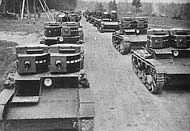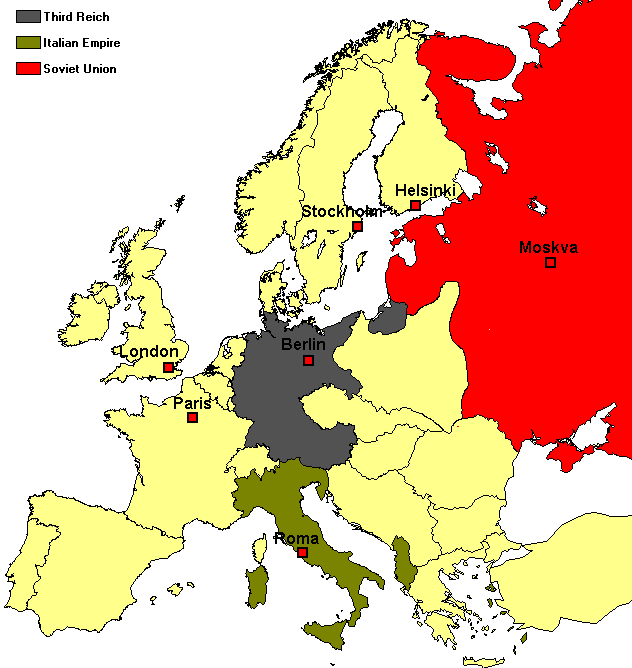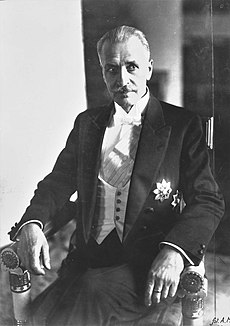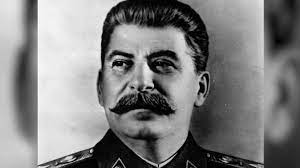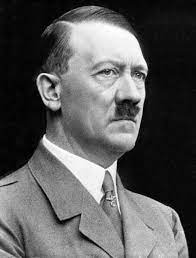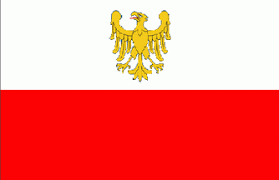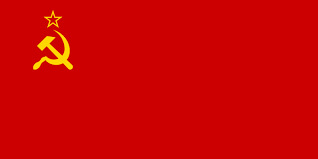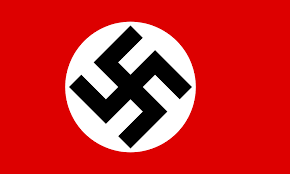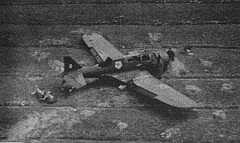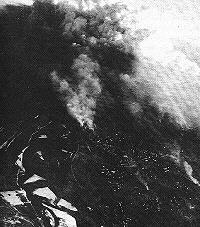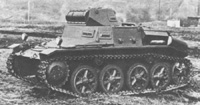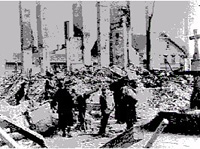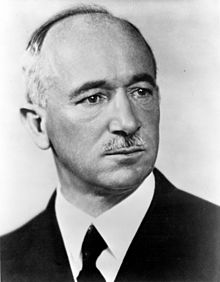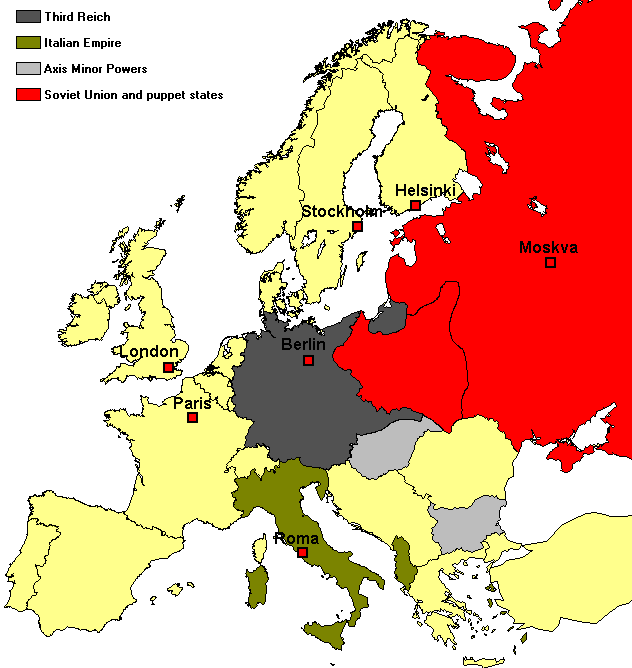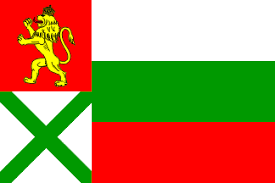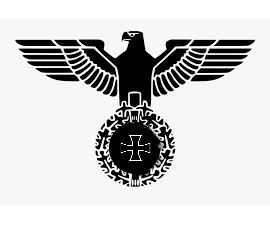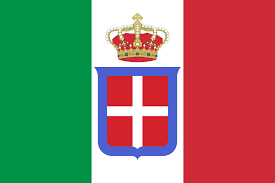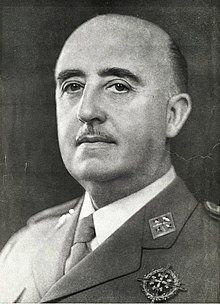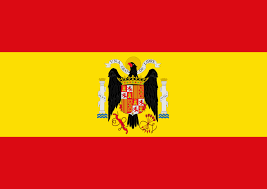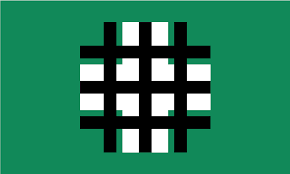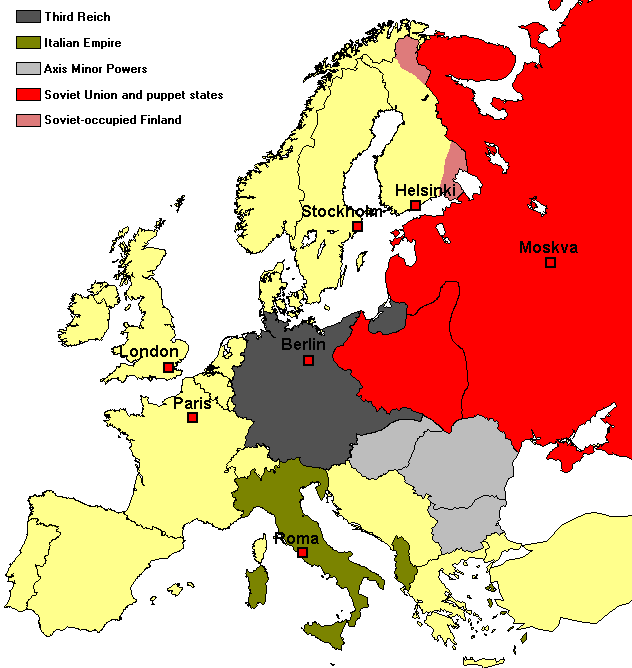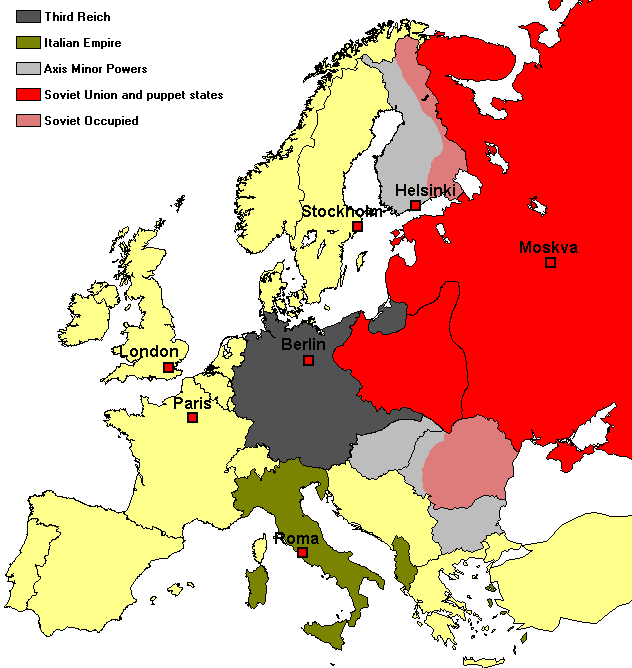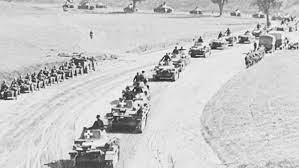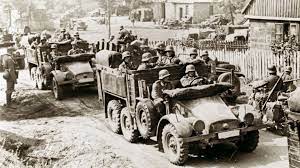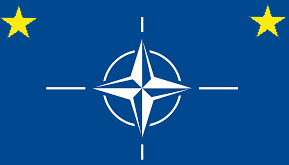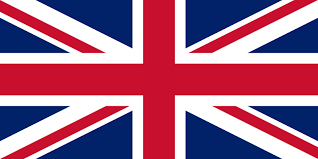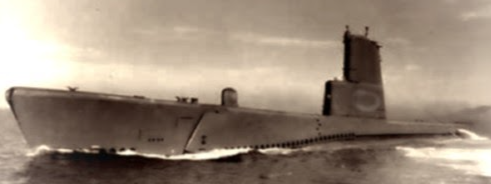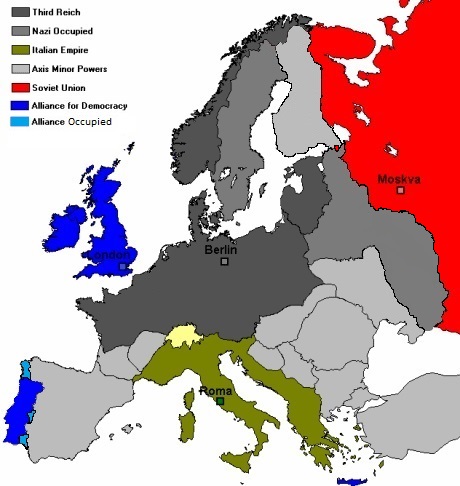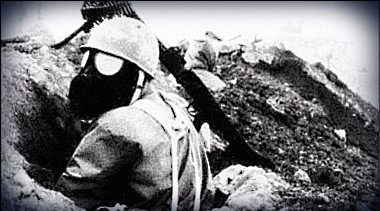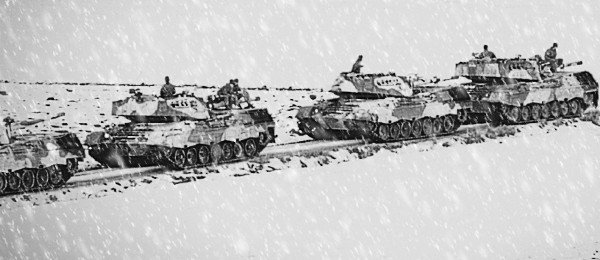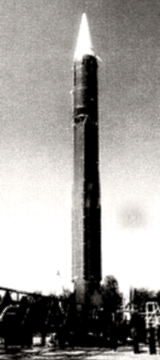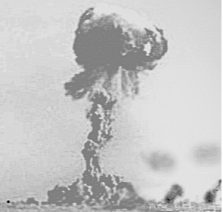The Soviet Union invades Poland Soviet - Polish War of 1937
Remove these ads. Join the Worldbuilders Guild

Shattered World Timeline
-
1937
11 September
The Eurasian War erupts
Military action -
1937
21 September
The Soviets have advanced 100 kilometers into Poland
Military action -
1937
12 October
Soviet forces surround Warsaw
Military action -
1937
23 October
Polish forces relieve Warsaw
Military action -
1937
2 November
Fresh Soviet offensive in southern Poland.
Military action -
1937
3 November
Warsaw surrounded by Soviet forces again.
Military action -
1937
27 November
The Fall of Warsaw.
Military actionThe Warsaw Garrison finally surrenders after running out of ammunition and food supplies.
Unconfirmed reports of Soviet massacres filter out of occupied Poland. Over four million Polish refugees manage to flee into East Prussia, Germany, Czechoslovakia, Hungary, and Romania before the Soviets gain effective control of the Polish western border. -
1937
2 December
Final capitulation of Polish forces.
Diplomatic actionThe Soviet Union installs a puppet communist regime in Poland and begins a harsh purge of Poland's old government structure and culture. 200,000 soviet soldiers remain in Poland to "insure civil order". A Polish government-in-exile flees to Germany. The Soviet - Polish War of 1937 comes to a close.
-
1938
3 January
Mutual Defense Pact signed between Germany and Czechoslovakia, German speaking lands of Czechoslovakia are annexed by Germany.
Diplomatic actionFear in central Europe of the Soviets gives Germany the leverage it needs to force a "mutual defense pact" with Czechoslovakia. The German speaking lands of Czechoslovakia are annexed by Germany as part of the agreement. The agreement is hailed by Britain and France as "the great wall against the communist threat"
-
1938
14 January
Czechoslovakia annexed by Germany
Military actionGerman forces cross the frontier into Czechoslovakia, occupying the country before it can begin to mobilize. Czechoslovakia is annexed by Germany almost immediately. Britain and France condemn the act but take no other action.
-
1938
22 February
The Polish "Home Army" detonates a bomb outside an NKVD headquarters in Warsaw
RevolutionThe Polish Home Army detonates a bomb outside an NKVD headquarters in Warsaw. In retaliation the Soviets kill one hundred suspected "Home Army" members and begin a harsh crackdown in Warsaw and other major Polish cities. More Soviet troops are brought into Poland to help quell any potential major uprisings.
-
1938
2 April
Soviet Union invades Finland
Military action -
1938
5 April1938
8 April
Soviet Forces suffer disastrous defeat in Finland
Military actionFinish troops repulse Soviet forces in the 1st Battle of Taipale. It is a humiliating defeat for the Red Army.
-
1938
2 May
A clash between German and Soviet aircraft over the Baltic Sea nearly sparks wider war
Diplomatic action -
1938
15 May
Field testing of the newer German Mk4 panzer prototype begins
Technological achievement -
1938
4 June
T-34 tanks begin appearing in Red Army units stationed close to Germany and Romania
Technological achievement -
1938
12 August
Riots erupt in Romania after the King dissolves the new Nazi-led parliament
Political eventThe Iron Guard Party wins a slight majority in the Romanian parliament. The King dissolves the new Nazi led parliament and calls for new elections. Large-scale riots break out in several major cities.
-
1938
18 August
Franco enters Madrid as the victor of the long and bloody Spanish Civil war
Diplomatic actionIn Spain Francisco Franco enters Madrid as the victor of the long and bloody Spanish Civil War. Spain becomes a fascist nation and is offered entry into the Axis Powers. Franco declines the invitation.
-
1938
23 August
Civil War erupts in Romania
Political eventA full scale civil war has broken out in Romania with the German backed Iron Guard fighting the loyalist forces of the Romanian monarch.The media in the west begins calling it "The Spanish Civil War all over again".
-
1938
2 September
Fascists seize power in Romania
Political eventIn the chaos the Iron Guard seizes the Romanian capital with the aid of several fascist-loyal infantry divisions, and sends the king into exile. A fascist government is declared. Soviet backed socialists resist the Iron Guard Party by calling on strikes and taking to the streets.
-
1938
3 September
Soviet forces begin to mass along the Romanian border.
Military action -
1938
6 September
German forces begin to enter Romania.
Military actionGerman forces mobilize and begin to enter Romania , which has been admitted to the Axis Powers earlier in the day. Germany declares that a Soviet invasion of Romania would be an act of war against all the Axis Powers.
-
1938
11 September
The Soviet Union launches a largescale invasion of Romania
Military actionThe Soviet Union launches a largescale invasion of Romania. All of the Axis Powers declare war on Russia within an hour of the invasion. Britain, France, and the U.S. condemn the invasion but urge both sides to avoid a greater war.
Chapter 3 in Shattered World : The Eurasian War
-
1938
22 September
Soviet forces drive deep into Romania
Military action -
1938
1 November
House to house fighting rages in the Romanian capital
Military actionWith Romanian and German resistance stiffening the Soviets require another month to grind 10 km into the outskirts of the Romanian capital. House to house fighting rages in the capital. German and Romanian snipers exact a heavy toll on Soviet infantry in the city and the Soviets begin to learn that rolling tanks into dense urban combat is not a good idea.
-
1938
6 November
German and Romanian forces finish destroying the Polesti oil fields just hours before Soviet soldiers occupy the facilities
Military actionGerman and Romanian forces destroy the Polesti oil fields just hours before Soviet soldiers occupy the facilities. Germany steps up it's bombing of Soviet supply lines and escalates the war by beginning to hit rail lines and supply depots in Odessa and other Soviet cities near the Romanian border in an effort to cut Soviet supply lines into Romania
-
1938
7 November
Red Airforce begins hitting transportation centers in Hungary and southeastern Germany
Military action -
1938
9 November
Artillery duels, small raids, and light bombing along the frontiers between Germany and the Soviet Union
Military action -
1938
13 November
Soviet Union opens a new offensive in Romania
Military actionWith the front largely stalled in southern Romania the Soviet Union opens a new front, attacking northwest in order to cut off German supply routes through the northwestern part of Romania.
-
1938
17 November
The Red Airforce bombs Berlin
Military action -
1938
3 December
Red Army begins a renewed southern offensive in Romania
Military action -
1938
10 December
Red Army drives Axis forces into Bulgaria
Military actionThe Soviet advance in southern Romania reaches the Bulgarian border. Surviving German and Romanian forces flee into Bulgaria. The Soviets begin to consolidate their gains. In the west Soviet forces are approaching the Hungarian border but are unaware of the Axis buildup occuring in southeastern Hungary.
-
1938
11 December
The Soviet Union begins tooling up for largescale mass production of the deadly T-34 tank
Technological achievementWith the outstanding performance of the few T-34's involved in the Romanian invasion just beginning to be appreciated, the Soviet Union begins tooling up for largscale mass production of the deadly Tank. Meanwhile German panzer commanders have become convinced that their panzers are in need of vast improvements. Already entering mass production is an "upgunned" Mk3 model with a 50mm cannon named the Mk3 Model G. In addition, development of the newer Mk4 model gains top priority.
-
1938
11 December 24:00
Fighting intensifies in Finland as German forces enter the theatre, expanding the extent of the Eurasian War.
Military actionThe resumed Red Army offensive in the far north is threatening to achieve a breakout as Finnish forces are being pressed to their absolute limits in the coastal stretches east of Helsinki. Luftwaffe and Red Airforce planes are clashing over southern Finland and the Baltic as German ships begin ferrying soldiers to aid in the defense of Helsinki. Soviet aircraft out of airfields along the Baltic coast are sinking some German shipping headed for Finland but not enough to cripple the effort. The Red Navy, what there is of it, remains bottled up in Murmansk and doesn't dare come out to face the Kriegsmarine. Finland has formally entered the Axis Powers and the war is spreading.
-
1938
13 December
Massive Axis Counter offensive unleashed in Romania
Military actionChapter 4 in Shattered World : The Eurasian War
The Axis Powers open up their counter offensive into Romania. A force of nearly 750,000 German, Hungarian, Romanian, and Italian soldiers and 2000 tanks move from railheads around Debrecen, a Hungarian city east of Budapest. German panzers streak ahead spearheading the attack. Infantry and minor axis forces follow, holding down Soviet forces. German Stukas range the front destroying everything that moves as medium range bombers hammer rail lines and transportation hubs behind the lines. The Red Airforce is slow to react and for the opening hours of the counter offensive the Luftwaffe owns the skies over western Romania. -
1938
19 December
Axis forces encircle 500,000 Soviet troops in Romania
Military actionTwo German panzer armies meet up at Cluj, successfully closing a Ring of Steel around 500,000 Soviet troops in western Romania. Further east the Soviet front is in complete chaos as Soviet forces stream eastward in a disorganized mass. German aircraft hammer fleeing columns further adding to the Soviet panic. The Luftwaffe, which has been massing in Hungary since the beginning of the war, is now seriously contesting the Red Airforce for air superiority over Romania. Neither side can quite gain the upper hand in the air. Soviet losses are heavier than what the Germans are suffering, but the Soviets have enough planes and pilots to absorb such losses for a long time.
-
1938
26 December
Two entire Soviet armies, over 400,000 men, surrender to the Axis Powers in western Romania
Military action -
1939
1 January
France and Britain declare the "Alliance for Democracy"
Diplomatic actionFrance and Britain sign a formal defensive pact named the Alliance for Democracy. The U.S. remains strictly neutral although her sentiment favors the Alliance and the Axis Powers over the communist Soviet Union.
-
1939
11 January
Stalemate settles in on the Romanian Front
Military actionThe war in Romania has fallen into a harsh stalemate. Axis forces have retaken all of western Romania, southern Romania, and the Polesti oil fields but cannot break the Roman - Bucharest line. The terrain is too rugged and the Soviets too well entrenched and supplied. The air war continues but harsh winter weather is hampering air activities. The Alliance for Democracy attempts to broker an armistice during this lull but both sides reject the attempt out of hand. The stalemate continues.
-
1939
20 January
Early Mk4 prototypes begin to arrive at the Romanian front for field testing
Technological achievement -
1939
26 January
Soviet forces continue a slow but steady advance towards Helsinki in Finland
Military actionSoviet forces continue a slow but steady advance towards Helsinki in Finland. More Soviet forces are now pushing towards Oulu and Tornio in northern Finland but a combination of rough terrain, harsh weather, and Finnish resistance is slowing the Soviet thrust. German infantry have only just begun to arrive in Finland in large numbers and are being carefully deployed as a strong reserve defensive force. German bombers, operating out of Finland, are beginning to hit Murmansk, Vyborg, Leningrad, and other cities vital in the supply of Soviet forces in Finland
-
1939
28 January
Norway and Sweden, seeking neutrality, rebuff offers to send troops by both the Alliance for Democracy and the Axis Powers
Diplomatic action -
1939
5 February
German submarine sinks British Merchant Ship
Diplomatic actionA German submarine operating in the Norwegian Sea attacks and sinks a British merchant ship, mistaking it for a Soviet blockade-running vessel. The British protest the action and some in Britain even call for war, but in the end the British people are not ready for war with the Axis Powers. Germany's blockade of the Soviet Union's northern ports continues despite the incident.
-
1939
9 February
Soviet forces reach the outskirts of Helsinki
Military action -
1949
25 November
U.S. forces entering Lisbon are met by cheering crowds
Military actionChapter 1 in Shattered World : Madness Ascendant
The two U.S. landings in Portugal have now fanned out, linked up, and secured Lisbon and other strategic points in western Portugal. More U.S. forces now begin to arrive at Portuguese ports despite intensifying German ballistic missile strikes. German and Italian forces, such as they are, have taken up positions to block or at least slow down any U.S. effort to advance deeper into the Iberian peninsula. Their task seems futile in the face of growing Alliance superiority in the region. -
1949
28 November
The U.S. Strategic Bombing Command launches operation ‘Tumble Down’
Military actionThe U.S. SBC (Strategic Bombing Command) undertakes operation Tumble Down, the largest single coordinated atomic attack of the war to date. In the span of five hours, seventeen atomic detonations will rock ‘Fortress Europa’ while seven atomic bombs will be lost in the skies over Europe, victims of downed B-34 bombers. -
1949
29 November
Germany begins reprisals for latest Alliance nuclear attacks
Military actionAt POW camps all around NAZI Europe, Gestapo and SS units begin liquidating Alliance prisoners by the many thousands. In a more direct retaliation, fifty ballistic missiles armed with VX and another seventy five conventional and sarin ballistic missiles slam into London, concentrated generally on industrial and residential sectors. Despite the widespread availability of chemical protection gear, London experiences nearly eighty thousand casualties immediately or in the aftermath of the attack.
-
1949
30 November
German advances into Soviet territory continue
Military actionDespite the atomic devastation in Western Europe; in the East the German advance continues. As German panzers stream into southern Russia, Luftwaffe bombers hammer Soviet rail lines south of Moscow. The last Soviet reserve army is attempting to deploy south to reinforce the thin Soviet lines on the Volga. Desperate for their reinforcements to make it through, the Soviets throw their last carefully husbanded Red Airforce strength and fuel reserves into securing these vital lines of communication.
-
1949
30 November 12:00
Soviet political police battalions have begun executing German and Ukrainian prisoners en masse as the Red Army Mutiny in southern Russia gains strength
Civil action -
1949
30 November 14:00
In Libya, British forces relieve the Benghazi pocket
Military actionIn Libya, British forces moving west from Tobruk link up with their forces east of Benghazi, relieving the Benghazi pocket. Following the atomic bombing of the fuel depot at Al Bayda, Axis Powers forces have retreated to the positions they held prior to the launch of their ambitious offensive. With much of its armor strength destroyed in the past few weeks, and now critically low on fuel, Army Group Africa has no choice but to go on the defensive.
-
1949
1 December
Pitched battalion and division scale battles raging between loyalist and mutineer Red Army forces in southern Russia
Military action -
1949
1 December 12:00
Loyal Red Army and political units are streaming in a disorganized mass east across thin Soviet lines at the Volga
Military actionIn the skies between Moscow and Beriagrad, a surge of Soviet fighters has temporarily renewed the air war over the Eastern Front. The Red Airforce pilots, mostly experienced veterans flying a mixture of aging British designed Meteor Jet fighters and late-model Soviet prop fighters, fight valiantly in the face of overwhelming odds - often resorting to ramming and suicidal runs at bombers to disrupt the intense German bombing campaign. The Soviet efforts are marginally successful, giving Soviet rail lines a brief respite at the cost of the last strength of the Red Airforce being spent.
-
1949
1 December 14:00
The last defenders of Kiev finally surrender
Military actionThe last defender's morale has been shattered by the mutiny to their east and relentless Axis chemical and conventional shelling.
-
1949
1 December 16:00
German mechanized forces have broken through four of the five defensive belts south and southeast of Leningrad
Military actionIn the north, German mechanized forces have broken through four of the five defensive belts south and southeast of Leningrad, advancing some 45 kilometers at the cost of two hundred thousand casualties and two hundred panzers destroyed. Sensing an end to the meat-ginder in sight, German commanders press home their attack, committing their armored reserve to the point of greatest penetration. The 5th SS panzer division surges forward.
-
1949
3 December
First German Type XXXII class submarine sinks four merchant ships in the mid-Atlantic
Technological achievementThe new submarine is a large diesel-electric attack model fitted with the latest surface scanning radar, sonar systems, many more batteries, and 12 torpedo tubes armed with cutting edge homing torpedoes. It marks the beginning of a new phase in the Battle of the Atlantic; large new German attack submarines gain the upper hand by operating solo and savaging Alliance convoys with submerged attack runs utilizing large torpedo volleys.
Chapter 3 in Shattered World : Madness Ascendant
-
1949
4 December
The Chilean civil war intensifies
Military actionThe Chilean Civil War intensifies with rebel and Junta forces engaging in fierce urban combat. SAFB aircraft have continued to hammer rebel forces and the U.S. now threatens to intervene with a “no-fly zone” if SAFB bombers continue to target civilian convoys and rebel-held cities. Top SAFB leadership reluctantly order their air forces to scale back operations to stave off direct U.S. intervention. In the capitals of the ODAS positions are beginning to harden against the SAFB as tensions in South America continue to escalate.
-
1949
6 December
U.S. forces have now occupied most of Portugal
Military actionU.S. forces have now occupied most of Portugal and are rapidly consolidating and firming up their logistical toehold on the continent. Hundreds of thousands of U.S. soldiers now pour into the Iberian peninsula despite intermittent German ballistic missile attacks. Axis Powers forces have begun to settle into a line of defense roughly along the Spanish border, paying particular attention to the approaches to central and southern Spain
-
1949
7 December
Leningrad under siege
Military actionChapter 4 in Shattered World : Madness Ascendant
German and Finnish forces link up east and north of Leningrad, completing the encirclement of the city. However, the Soviets have stockpiled vast amounts of supplies. The Germans, having suffered some 250,000 casualties in the massive effort to take the city since October, are content for the moment to consolidate their encirclement. German artillery and bombers hammer the city day and night as German armor and mechanized forces probe further east and north. -
1949
7 December 11:00
German pincer movements link up just east of Tula and put that city under siege
Military action -
1949
7 December 13:00
Axis forces occupy Voroshilovgrad and Rostov
Military actionLoyalist Soviet forces are in headlong retreat across southern Russia and the northern Caucasus towards the line of the rivers Don and Volga where Beria’s Soviet Union prepares to make a “final great stand against the fascist enemy” as radio Moscow puts it.
-
1949
8 December
U.S. makes a new amphibious landing in southern Spain near Malaga
Military actionU.S. forces are hoping to flank Axis Powers forces massing around Sevilla. Two divisions come ashore with only light resistance from Spanish units in the area and begin to fan out and consolidate the beachhead. In the western Mediteranan Italian submarines and torpedo boats continue to harass U.S. naval forces but the weight of American firepower has forced the remaining bulk of the Italian navy to take shelter in the central Mediteranean under land-based air coverage.
-
1949
8 December 12:00
Chinese communist insurgency rages on
Political eventIn northeastern China the communist insurgency, supported from PLA bases inside communist Manchuria, continues to rage. However, nationalist Chinese forces supported by U.S. arms and advisors have so far managed to contain the insurgency mostly to the countryside. Nationalist threats to invade Manchuria or bomb PLA bases across the border have so far amounted to rhetoric as the U.S. and Soviet Union apply pressure to both sides to prevent the situation from escalating.
-
1949
10 December
Alliance blockade and bombardment of Japan continues
Military actionProwling U.S. submarines and maritime aircraft have severely hampered Japanese lines of communication between the Home Islands and Korea as the U.S. continues to tighten its crippling blockade of Japan. On the Home Islands themselves massive conventional and chemical raids continue to hammer Japanese cities several times a week though it has now been some time since any atomic attacks on Japan. On Okinawa, Taiwan, islands in the central Pacific, and even coastal China and the Philippines U.S. forces have been massing now for many months as the U.S. general staff continues to debate whether to simply maintain the blockade of Japan or to set a Spring invasion date. One thing is clear, nothing less an unconditional Japanese surrender will be contemplated.
-
1949
12 December
Alliance atomic strike wipes out Baku
Military actionDespite heavy Axis Powers air resistance, Alliance heavy bombers launch a massive raid on Baku with both conventional and atomic munitions. All four 40 kiloton atomic bombs involved in the strike arrive on target. For all intents and purposes the bulk of the Baku oil fields have simply ceased to exist. The Axis have been dealt a very heavy blow.
-
1949
13 December
In southern Spain Axis forces have been forced to withdraw from Sevilla
Military actionAxis Powers forces are pulling back into central Spain and to positions in the rugged terrain East of Malaga in the south. U.S. forces pushing out of Malaga have already linked up with U.S. divisions pushing East from Portugal to occupy a large swath of southwestern Spain.
-
1949
13 December 12:00
Alliance forces continue to roll back Axis forces in North Africa
Military actionAdvance U.S. forces, scouting far ahead of the main columns pressing into Algeria, have reached Oran. U.S. bombers are hammering logistical hubs, air fields, and troop concentrations from Algiers to Tunis while British and American air power operating out of Egypt does the same in Libya. The Axis Powers still have significant airpower in North Africa but the sheer weight of U.S. airpower is grinding them down. The Axis Joint Command for the Mediteranean theatre begins preparations for an organized evacuation of North Africa with reluctant approval from Hitler and Mussolini.
-
1949
15 December
Pro-Axis nationalist coup in Syria consolidates power
Political eventThough proclaiming independence the new nationalist Syrian government has taken a radically pan-arab position, spoken favorably of the Axis Powers and nationalist rebels in Egypt and elsewhere, and called on all colonial powers to leave the arab lands in the middle east. British forces have massed at the Palestinian/Syrian frontier but have thus far not directly intervened other than to allow fleeing Free French forces to join them inside Palestine. However, late this day the Alliance for Democracy issues an ultimatum to Damascus, demanding the restoration of the French Mandate in Syria and threatening war if this demand is not met.
-
1949
17 December
The new German two-stage A-6 rocket secretly lofts a small satellite into Earth orbit
Technological achievementThe NAZI satellite broadcasts a simple series of tones and pings at set intervals for test purposes. Von Braun has finally realized his vision to usher in the space age...though only a few in the upper echelons of the German High Command and inner circle of the NAZI party are aware of this fact. The A-6 rocket, part of a German program to develop “artificial Earth orbiting satellites” for military and civil applications, is a heavier and specially modified variant of the A-5 which itself is a road-mobile two-stage intermediate ranged ballistic missile designed to reach the East Coast of North America. The A-5 is planned to be operational by early to mid 1950.
-
1949
19 December
Alliance and Axis forces consolidate positions in Iberia and North Africa
Military actionIn Iberia the fighting has diminished as Alliance forces consolidate their gains in the face of increasing German ballistic missile strikes on Portuguese port cities, including a growing use of nerve gas. Axis forces, still thinly stretched for such a broad front, have pulled back to more defensible lines in central and southern Spain In North Africa Axis forces dig in for a rear guard defense in Algeria and Libya while the first waves of transports have begun to ferry Axis forces to Sicily and other islands across the central Mediterranean; the Axis withdrawal from North Africa and fortification of the central Mediterranean is underway.
Chapter 5 in Shattered World : Madness Ascendant
-
1949
21 December
German offensives in northern Russia grind to a halt after major gains
Military actionGerman forces halt their probes northeast and East of besieged Leningrad and initiate operational pauses in their pincer movements north and southeast of Moscow as winter weather, Soviet resistance, and fuel shortages force a halt to offensive operations. Stalemate sets in across the northern front as the Soviets themselves lack the fuel and reserves to sustain a strong counter-offensive beyond localized pushes.
-
1949
21 December 11:00
Front in Southern Russia stabilizes at the Volga
Military actionSoviet loyalist forces have largely suppressed the Red Army Mutiny in the south but Axis Powers mechanized forces have made a broad sweeping movement from rail heads in Ukraine all the way to the Volga frontier with little effective Soviet resistance. However growing Soviet resistance anchored on Beriagrad, and overly stretched Axis logistics, have combined to stabilize the front. The remnants of the Soviet spy network inside Germany have informed Beria that the German High Command has called a halt to offensive operations in the East until the Spring and Beria and Stavka are content to continue to build up defenses along the Volga and focus on the dire situation in the Moscow salient.
-
1949
25 December
"Black Christmas" German atomic strikes on port of Liverpool and central London
Military action -
1949
26 December
Axis - Soviet ceasefire talks initiated
Diplomatic action

